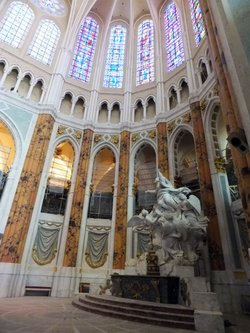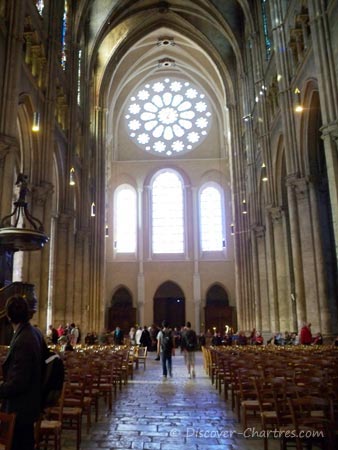Who was it that said one look at Chartres Cathedral turned him into an art historian? Or art-lover for life? Henry Adams? Bernard Berenson? I can’t remember, but it was probably more than one person. Kenneth Clark called it “one of the two most beautiful covered spaces in the world” (Hagia Sophia in Istanbul being the other).
 Maybe not anymore. Hear what Martin Filler, writing on the website of The New York Review of Books, has to say after a recent visit:
Maybe not anymore. Hear what Martin Filler, writing on the website of The New York Review of Books, has to say after a recent visit:
Carried away by the splendors of the moment, I did not initially realize that something was very wrong. I had noticed the floor-to-ceiling scrim-covered scaffolding near the crossing of the nave and transepts, but had assumed it was routine maintenance. But my more attentive wife, the architectural historian Rosemarie Haag Bletter—who as a Columbia doctoral candidate took courses on Romanesque sculpture with the legendary Meyer Schapiro and Gothic architecture with the great medievalist Robert Branner—immediately noticed that large areas of the sanctuary’s deep gray limestone surface had been painted.
The first portion she pointed out was a pale ochre wall patterned with thin, perpendicular white lines mimicking mortar between masonry blocks. Looking upward we then saw panels of blue faux marbre, high above them gilded column capitals and bosses (the ornamental knobs where vault ribs intersect), and, nearby, floor-to-ceiling piers covered in glossy yellow trompe l’oeil marbling, like some funeral parlor in Little Italy.
I haven’t seen this first-hand, obviously, but it sounds like a mess. Take a look at the top photo–that’s what is underway. I couldn’t find an exact parallel picture on the web (though there may well be one), so I posted something similar from Chartres.
What is this impulse to make everything new–even if it is a wrong-headed attempt to restore to the original? I’m not against conservation by any means, but this one does surely seem wrong.
I also agree with another of Filler’s points: “why had we heard nothing about [this] before?” It is, after all, a UNESCO World Heritage site. Where was the French press? Where was the European art press? Or did they cover it, and we missed it?
Filler says this effort dates to 2009, when the French culture ministry set out to “do no less than repaint the entire interior in bright whites and garish colors that are intended to return the sanctuary to its medieval state. This sweeping program to “reclaim†Chartres from its allegedly anachronistic gloom is supposed to be completed in 2017.”
 Here’s what’s wrong with that:
Here’s what’s wrong with that:
The belief that a heavy-duty reworking can allow us see the cathedral as its makers did is not only magical thinking but also a foolhardy concept that makes authentic artifacts look fake. To cite only one obvious solecism, the artificial lighting inside the present-day cathedral—which no one has suggested removing—already makes the interiors far brighter than they were during the Middle Ages, and thus we can be sure that the painted walls look nothing like they would have before the advent of electricity.
Furthermore, the exact chemical components of the medieval pigments remain unknown. The original paint is thought to have flaked off within a few generations and not been replaced, so for most of the building’s eight-century history it has not been experienced with painted surfaces. The emerging color scheme now allows a direct, and deeply disheartening, before-and-after comparison.
He has many more details, disheartening ones, plus another picture or two of the repainted areas.
But, alas, this seems unstoppable. If you have not already been to Chartres, and luckily I have, it may be too late.
